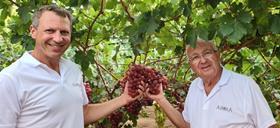
Climate change stands as the greatest challenge facing table grape growers today, according to Shachar Karniel, breeder of the Arra varieties and the fourth generation in a family of grape producers dating back to 1882. “2021 is the first year that we have seen clear signs of climate change in three major grape-producing countries at the same time,” he says.
This year, South Africa, Chile and Brazil witnessed intense rain and damaging storms, with such conditions posing an almighty test to growers and to those charged with developing the grapes of the future.
However, with the very real prospect of worsening extremes on the horizon, Karniel believes the Arra varieties programme is well placed to respond.
“Over 20 years ago, when I established my gene pool, I focused on extreme-weather-tolerance characteristics on both sides, extreme heat as well as cold and rain resistance,” says Karniel. “By cross-breeding them, we created varieties that contain genes from both such extremes. Our varieties can grow in dry areas and also be resistant to severe rain when it comes, as happened last year in Chile, South Africa and Brazil, avoiding big losses.”
Understandably, then, Arra grape varieties are in high demand. “Growers across the world are turning to our varieties,” says Rafi Karniel, CEO of Grapa Varieties and Shachar’s son. “We operate in over 30 countries, and that is because we have stable, productive varieties that are resistant to changing climatic conditions and allow us to face most kinds of weather.”
“We go to places that are on the edge of impossible,” resumes Shachar, “but we trust the genetic profile of our varieties. When it comes to new territories, sometimes there are old, seeded varieties growing there that have little commercial potential, and we provide better selections for these growers to supply their local market, but also to start exporting.”
According to Rafi Karniel, the important thing is to choose varieties that are cost-effective and easy to grow, as well as ones with good colour, size and eating quality. “Coming from a family of farmers, when we develop varieties we look at the farmers’ side,” he says. “Many growers are just managing to hold their heads above water, so we think about how we can make their lives easier. Thanks to the natural resistance of our varieties, they require less manual labour and chemical inputs, reducing costs and helping the environment.”
Additionally, he says, the Arra programme has increasingly been focusing on shelf-life. “For most consumers it is all about the appearance on the shelf,” he says. “We want them to look nice, healthy and fresh. Some companies try to give the consumer as much information as possible on the label and packaging,, but there is a limit to the consumer’s attention. Most consumers are struck by a nice appearance, and then they come back for the taste and eating experience. So we are putting a lot of effort into having varieties that look fresh even after several days on the shelf. We look forward to presenting our grapes on our stand at Fruit Attraction in Madrid.”



